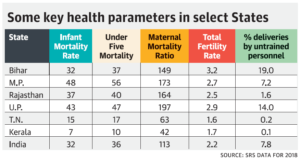In news : In the wake of the COVID-19 pandemic, there have been vociferous demands to strengthen the country’s public health system
Why is the health sector neglected?
- The efficacy of the public health system varies widely across the country since it is a State subject
- Since health is a State subject, the primary onus lies with the State governments.
- Each State government must focus on public health and aim to improve the health indicators mentioned below. But the state of health varies from states to states
- Currently, a Public Health system is judged by only few parameters such as Infant Mortality Rate, Maternal Mortality Ratio and Total Fertility Rate for which annual surveys are conducted through the Sample Registration System
- Unless all the States perform well, there will be no dramatic improvement in the health system .
- It is sad this is the outcome despite Finance Commissions pouring non-Plan funds into these States in addition to substantial Plan allocation from the Ministry of Health and Family Welfare for the Empowered Action Group States.
Following are the highlights of key health parameters

- With the numbers given in the chart, it is doubtful whether India will be able to achieve Goal 3 (good health and well-being) of the Sustainable Development Goals (SDGs) set by the United Nations General Assembly in 2015.
- India failed to achieve the earlier Millennium Development Goals because of the poor performance of the northern States.
Poor performance
- As per the above data, the northern States are performing very poorly in these vital health parameters.
- In Madhya Pradesh, the number of infant deaths for every 1,000 live births is as high as 48 compared to seven in Kerala.
- In U.P. the Maternal Mortality Ratio is 197 compared to Kerala’s 42 and Tamil Nadu’s 63.
- The percentage of deliveries by untrained personnel is very high in Bihar, 190 times that of Kerala
- Another vital parameter that has an impact on poverty, Total Fertility Rate, is very high in Bihar (3.2) against the stabilisation rate of 2.1.
- Tamil Nadu and Kerala have done so well that their population will decline over the years
- Some of these States are performing so poorly that they are comparable to the poorest countries in the world, pulling down the average for India.
Example of Tamil Nadu
The state of Tamil Nadu performed well in the above mentioned parameters, following are the reasons why Tamil Nadu performed well:
- It is because of enlightened political leadership which was interested in the health and well-being of the people
- The had organized the family planning drives and innumerable camps to eradicate cataract in the 1970s
- The district administration was spearheading these health initiatives because of the government’s focus and drive.
- The government encouraged a healthy competition among the districts by giving prizes to the well-performing ones.
- By the 1990s, family planning drives were no more necessary, and all that was needed was some fine-tuning of the Maternal and Child Health programme.
- The result is that the Total Fertility Rate of Tamil Nadu is among the lowest in the country (1.6) comparable to that of Germany (1.57) and Japan (1.43).
- In addition to a clear focus by the political executive, Tamil Nadu has the advantage of a public and preventive health structure.
- A good administrative structure could therefore deliver to the demands of the political executive, benefiting the people of the State.
Way forward
The governments — both at the Centre and the Empowered Action Group States — should realise that public health and preventive care is a priority and take steps to bring these States on a par with the southern States.
Public and preventive health should be the focus of Union government by holding the Empowered Action Group States accountable to the SDGs. They must be asked to reach the levels of the southern States within three to five years.
















